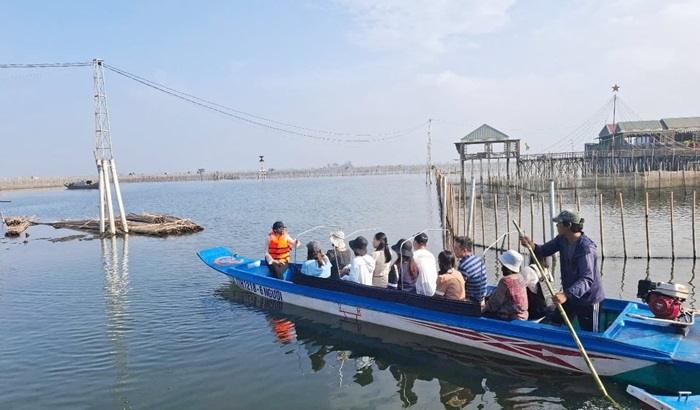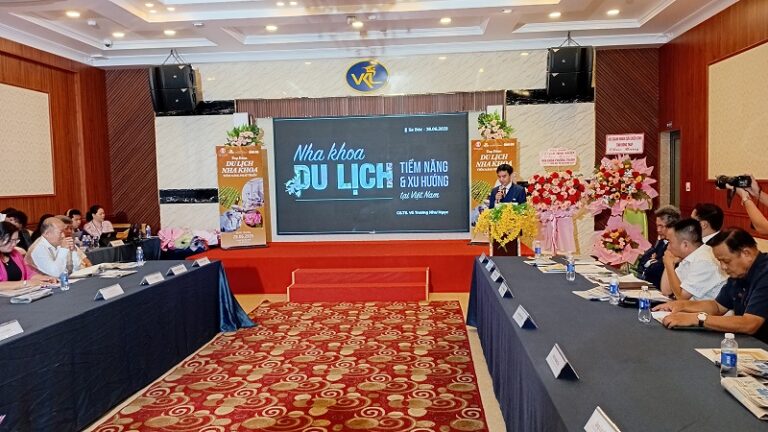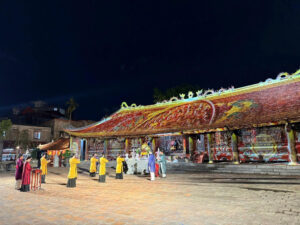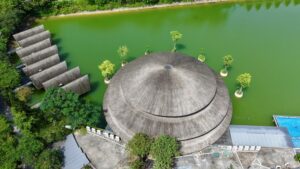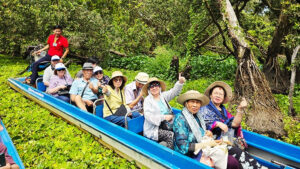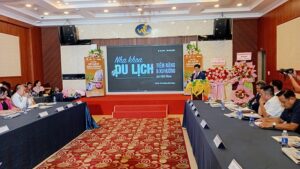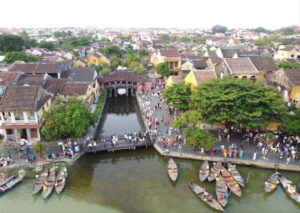Thanh Chuong Viet Art Museum is not an ordinary museum. Instead of displaying pieces of history from behind glass, here, only 40 km from Hanoi, visitors can experience some of the rich diversity of traditional Vietnamese culture with all five senses.
The museum is in Soc Son District, about 40 km from Hanoi city centre and was set up by painter Thanh Chuong in 2001. In the beginning, the artist simply wanted to share his collection of ancient artifacts, some over a century old, but the museum quickly grew into a 10,000 sq.m area which includes reconstructions of buildings typical of different groups of Vietnamese society.Through the traditional wooden archway carved with two dragons, the gateway to the village reveals the Thanh Tinh House. It is the first stop, and the grandest. The house was reassembled from a 200-year-old building in Nam Dinh province and is made from a rare Vietnamese dark wood called lim (iron wood). Although originally owned by Christian family, the house is now home to a Buddhist altar. Also on display are some antiques dating back 700-800 years to the Tran dynasty. A delicately carved wooden screen, popular with rich families in the past, is also on display.A stone’s throw from Thanh Tinh is a very different structure – a traditional stilt house built about 100 years ago by ethnic Muong people in Hoa Binh province. Normally, the area under the house is used to keep buffaloes and cows and the building above is used as the family living space. But Chuong adapt the house by adding brick pillars under the stilts. This he uses as a visitors’ room.A stilt house is very difficult to build, especially the thatched roof, says Ngo Huong, Chuong’s wife. “The thatch is made from sedge. To reconstruct the house, sedge was brought from Nam Dinh and nine experts also from the province were hired to build the roof. The men were between 70 to 80 years old.Just a few metres away, it is another world of cultural tradition – a typical peasant home made by Vietnamese ethnic majority Kinh farmers. The house is made of bamboo and held together with clay. A rice-hulling mill and other agriculture tools are hung on the outside walls to give visitors at glimpse of how the house might have looked in the past.Thanh Chuong still waxes lyrical about the house. “I’m very attached to this house. I lived in one very similar when I was a child. I built this one two years ago to recall my childhood,” Chuong says.
“Rapid urbanization is eating up a lot of these traditional homes, he says, so it is becoming rarer to see them in the countryside.”Dotted in between the buildings are typical agriculture tools used in the country, like casting-nets, lift nets or bamboo fish traps. Visitors are free to try them out and get a feel of what country living is all about. They can even try some traditional “voi” water, made from the leaves of a tree of the same name. Getting a hands-on experience of traditional Vietnamese culture is why a lot of people come to the museum, says Nguyen Thi Nhat, an overseas Vietnamese living in France. “I come here with my nephew to teach him more about daily life and the beauty of the Vietnamese countryside. Coming here reminds me of what life used to be like in my homeland in Bac Ninh province. Everything here is in harmony with nature. It’s amazing.” Thanh Chuong agrees. “It’s good for kids to come here during the Tet holidays so they can learn how to make traditional preparations for Lunar New Year, like making Banh Chung (sticky rice square cake with beans and fork) and watch people killing a pig in the traditional way.” To enjoy more traditional customs, the museum also hosts performances of Ca Tru (ceremonial singing), Cheo (traditional opera), and Quan Ho (duet singing) in its grand meeting hall, which can seat 40 people. “We also plan to open an exhibition area for contemporary art in the space underneath it,” says Huong. The couple also built a stage to hold water puppetry shows next year. At the moment, the visitors can drop into the museum whenever they want, Huong says. But that is set to change. The couple plan to open the village free two days a week and have special days for tour groups. The village is not just a fun day out for the family, it’s also important for Vietnamese and foreigners to learn more about the country they are in, says Nguyen Khoa Diem, former head of the Party Central Committee’s Ideological and Cultural Department. “The museum keeps alive the spiritual values of traditional arts and culture. Chuong is not only a painter but also a cultural activist.” Visitors to the village, art historian Julian Brown from England agrees. “This is the first time I’d heard about the museum. It’s very interesting to see examples of architecture from around the country, old and new. I’m very impressed. I’ll definitely tell my friends about this place.”


